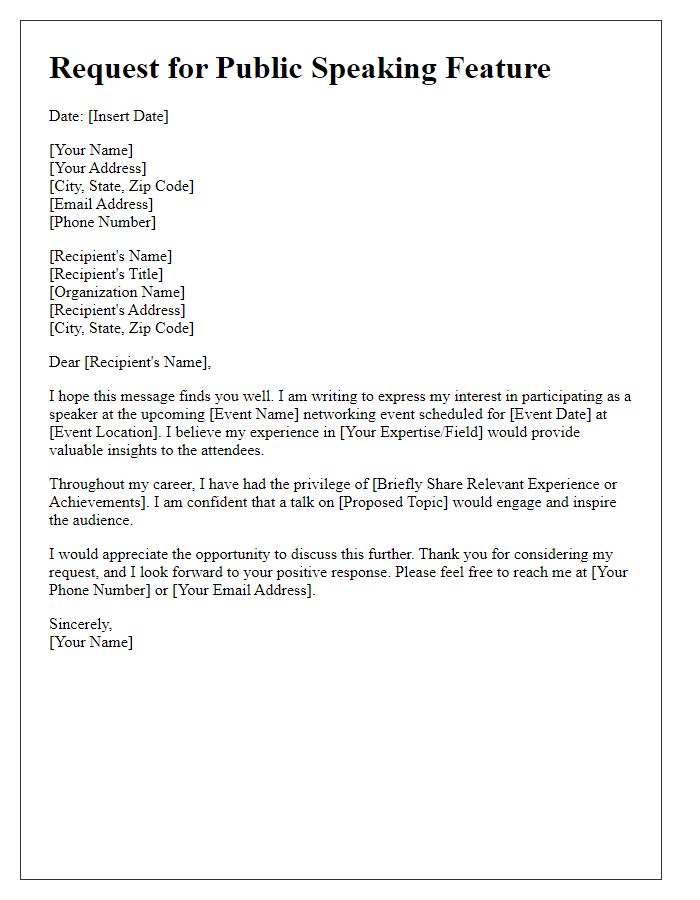Are you passionate about sharing your knowledge and expertise with a wider audience? If you've ever considered stepping into the spotlight to inspire others, a public speaking session might be just what you need. Whether you're an industry expert, a motivational speaker, or someone with a compelling story to tell, this could be your moment to shine. Join us as we explore how to craft the perfect request for a public speaking session!

Audience Profile and Interests
Public speaking sessions cater to diverse audience profiles, such as students aged 18-24 in universities, professionals in corporate settings, or community groups focused on personal development. Students often seek motivation, career guidance, or insights into industry trends. Corporate professionals may be interested in leadership skills, innovation strategies, or effective communication techniques. Community groups typically look for engaging topics around mental health, self-improvement, and local issue advocacy. Understanding these interests ensures tailored content, maximizing audience engagement and learning outcomes.
Speaker Credentials and Expertise
A request for a public speaking session requires highlighting the speaker's credentials and expertise. Effective public speakers often possess a combination of educational qualifications, professional experience, and notable achievements relevant to their field. For instance, a speaker with a PhD in Psychology from Harvard University and over 15 years of experience in mental health advocacy can bring a wealth of knowledge to topics such as mental resilience and emotional well-being. Additionally, having delivered keynote addresses at major conferences like the American Psychological Association Annual Convention further establishes their authority. Industry recognitions, such as awards from professional organizations, also reinforce their credibility. Providing a brief overview of significant publications, podcasts, or media appearances can further illustrate the speaker's engagement with a broader audience, showcasing their ability to communicate complex ideas effectively.
Event Objectives and Goals
Public speaking sessions serve to educate audiences on pivotal topics. These events aim to foster community engagement and inspire action while providing valuable insights from industry experts. Objectives include enhancing knowledge through expert presentations, encouraging networking opportunities among participants, and promoting discourse surrounding relevant issues. Goals focus on achieving a minimum attendance of 100 individuals, gathering feedback to improve future events, and disseminating key takeaways through digital platforms. These sessions often occur in venues like community centers or universities, providing accessible spaces for diverse groups to interact and learn together.
Duration and Format of the Session
A public speaking session on effective communication skills typically lasts 60 minutes, divided into several key segments. Key points often include a 15-minute introduction to fundamentals, covering topics such as body language and vocal modulation. Following that, a 30-minute interactive practice session encourages participants to engage in small group activities, enhance their delivery techniques, and receive peer feedback. The final 15 minutes usually consist of a question-and-answer segment, allowing attendees to clarify doubts and share personal experiences, fostering an enriching dialogue about public speaking strategies. This format is designed to ensure both information retention and active participation in various learning styles.
Venue and Technological Needs
When organizing a public speaking session, understanding venue specifications is crucial. An appropriate venue should accommodate at least 200 attendees, with adequate seating arrangements for comfort and visibility. It is essential to ensure accessibility features for individuals with disabilities, including ramps and designated seating. Technological needs encompass a high-quality audio system to facilitate clear sound projection, projection screens capable of displaying presentations, and reliable Wi-Fi connectivity for both speakers and attendees. Additionally, microphones, preferably wireless for ease of movement, and video recording equipment can enhance the session, ensuring effective engagement and potential future distribution of the content delivered.
Letter Template For Request Public Speaking Session Samples
Letter template of request for a public speaking engagement at a conference.

Letter template of request for a public speaking opportunity at a workshop.

Letter template of request for a public speaking session at a community event.

Letter template of request for a public speaking role at a school assembly.

Letter template of request for a public speaking invitation at a corporate event.

Letter template of request for a public speaking feature at a networking event.

Letter template of request for a public speaking session at a university seminar.

Letter template of request for a public speaking appearance at a fundraising gala.






Comments